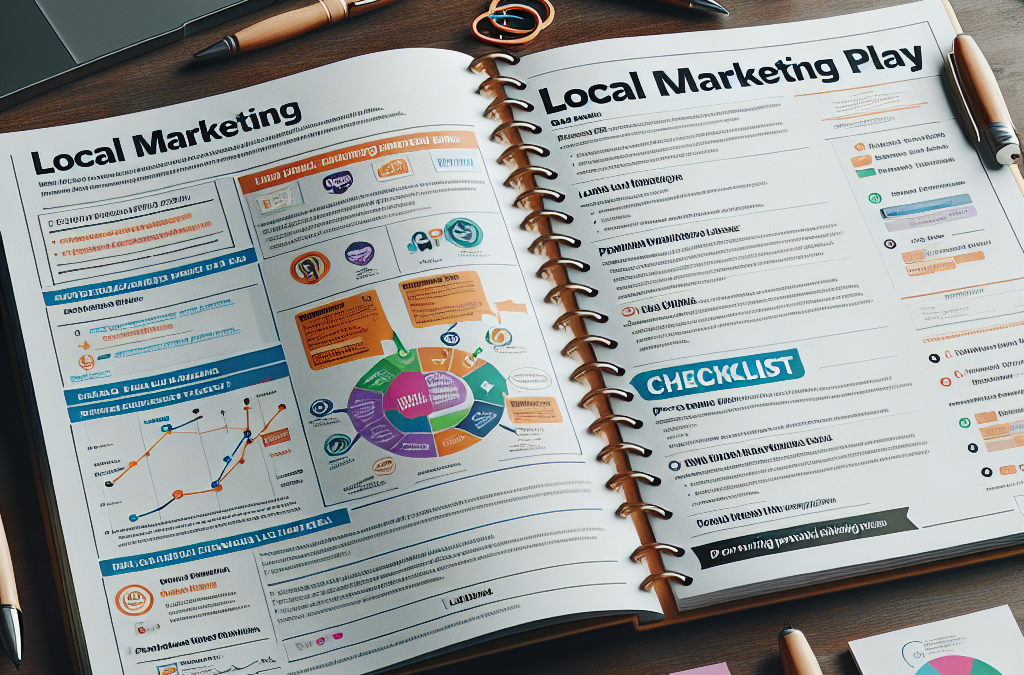Hey there! I’m excited to talk about a topic that has really helped me connect with my community and take my business to the next level: creating a local marketing playbook. Whether you’re a small business owner or part of a larger organization, having a playbook specific to your local market can be a game changer. Over the years, I’ve nailed down a process that consists of five major components that I believe are essential for setting up a tailored local marketing strategy. Let’s dive right in!
Understanding Your Local Audience
First things first—understanding who your audience is in your local area is crucial. It’s not just about demographics like age or income; it’s about the nitty-gritty of their habits, preferences, and values.
Researching Demographics
Start with basic demographic data. You can use tools like the U.S. Census Bureau or local government websites. But don’t stop there! Dig deeper into who these folks are, what they love, and what kind of problems they face that your business can solve.
Talking to people directly is invaluable. Ask your customers and potential customers about their experiences, preferences, and needs. You’d be surprised how much you can learn by just asking the right questions. It’s like unlocking the doors to your audience’s heart!
Lastly, don’t forget about the online aspect. Social media is a goldmine for insights. Check out local groups, hashtags, and community events to see what’s trending and what matters to people in your area.
Identifying Trends and Preferences
Next up, you want to spot the trends and preferences within your local community. Are there growing niches? What’s the latest craze? For example, if coffee shops are popping up everywhere, maybe people in your area are looking for cozy places to chill and sip their lattes.
Observe local events, fairs, and markets. Pay attention to what kinds of businesses are thriving. Engage with local influencers who are already in tune with the community—they can give you some serious insight into the local flavor and what resonates.
Don’t overlook the power of online reviews, either. Sites like Yelp and Google Reviews not only show you what people think about existing businesses but also reveal gaps in the market that you can tap into. It’s like having a focus group at your fingertips!
Creating Customer Personas
Based on your research, it’s time to create customer personas. These are semi-fictional characters that embody the traits of your ideal customers. By creating these personas, you’ll be better equipped to tailor your marketing messages and tactics.
For instance, you might create a persona called “Busy Parent Betty.” She values convenience and local services that save her time. Knowing about Betty can guide your marketing efforts towards family-friendly promotions or local events that cater to parents and kids.
Once your personas are established, revisit them regularly. Your local audience can shift over time, and keeping these personas fresh will ensure you stay relevant in your marketing approach.
Defining Your Unique Value Proposition
Now that you understand your audience, let’s talk about what makes you special. Your unique value proposition (UVP) is what sets you apart from the competition. It’s what makes customers choose you over someone else.
Evaluating Your Competition
Take a close look at your competition. What do they offer? How do they market themselves? Doing this will help you spot areas where you can differentiate your business. Maybe they’re all focusing on upscale products while you provide affordable options without sacrificing quality.
Plus, customer feedback on competitors can give you a goldmine of insights. What do people complain about? What do they rave about? Use this information to carve out your niche and position your UVP clearly.
Just remember, don’t get too caught up in their strategies. Focus on what YOU can bring to the table that will resonate with your local audience. Each community is unique, and so should be your approach!
Cultivating Your Brand Voice
Your unique value proposition goes hand-in-hand with your brand voice. This is how you communicate with your audience, whether it’s through social media, email, or in-store interactions. Keeping it consistent and relatable will help you create a stronger bond with your local customers.
Think about the personality you want your brand to convey. Are you friendly and approachable, or more formal and professional? Tailor your voice accordingly; injecting a bit of your personality will help in establishing authenticity.
And don’t shy away from having a bit of fun! People like to engage with brands that have a sense of humor or show their quirky side. By letting your brand’s character shine through, you’re more likely to create memorable experiences for your customers.
Articulating Your Message Effectively
Once you’ve defined your UVP and brand voice, it’s time to articulate your message effectively. This means crafting powerful statements that deliver your value succinctly, whether it’s for an ad, a social post, or even a conversation with a potential customer.
Use your customer personas to guide your messaging. Speak directly to them! For “Busy Parent Betty,” you might emphasize convenience and ease in your promotions, while for “Outdoor Adventure Andy,” you might highlight the thrill of your offerings.
Don’t forget to test and revise your messages regularly! This ensures they are resonating with your intended audience and reflects any changes in trends or preferences.
Choosing the Right Marketing Channels
Now, onto the nitty-gritty of marketing channels. There are a plethora of options available, and choosing the right ones can make or break your local marketing strategy.
Exploring Digital Marketing Options
In today’s digital age, an online presence is a must. Platforms like Facebook, Instagram, and Google My Business are essential for showcasing your local business. Ensure your profiles are optimized with accurate information, images, and engaging content.
Consider leveraging local SEO strategies to ensure residents in your area can easily find you online. This means using location-based keywords, optimizing your Google listing, and encouraging satisfied customers to leave positive reviews online.
Additionally, pay attention to paid advertising opportunities. Social media and search engine ads can target your local audience specifically, making it easier to draw in customers who are likely to convert.
Utilizing Traditional Marketing Techniques
While digital is significant, don’t underestimate the power of traditional marketing techniques. Flyers, posters, and local newspapers can still be incredibly effective in a local context. Engaging with local radio stations for advertising is another excellent avenue.
Hosting or sponsoring community events is a fantastic way to increase your visibility and establish your presence among potential customers. Giving back to the community often leads to stronger ties and new customer relationships.
Networking is key! Partnering with other local businesses can create opportunities for joint marketing efforts that benefit you both. Consider co-hosting an event or running cross-promotions that highlight the local community.
Engaging Through Community Events
Being active in community events is vital for any local marketing strategy. Whether it’s farmers’ markets, festivals, or workshops, getting involved showcases your commitment to the community and builds your reputation.
Propose to set up a booth or sponsor an aspect of these events. This turns a mere presence into a meaningful interaction with the community. Sharing live updates on social media during the event can further blow up your visibility!
Building relationships with local organizations is equally crucial. Attend their meetings, listen to their needs, and see how your business can contribute. By becoming an integral part of the local landscape, your business will benefit immensely.
Tracking and Measuring Success
Finally, let’s talk about the importance of tracking and measuring your marketing success. You can’t improve what you don’t measure. Regular assessment of your local marketing efforts will give you insights into what’s working and what needs tweaking.
Setting Key Performance Indicators (KPIs)
What do you want to achieve? It’s important to set clear KPIs that align with your business goals. Whether it’s increased foot traffic, more social media engagement, or growing customer lists, specific KPIs provide tangible targets.
Once you have these KPIs in place, make it a habit to review them regularly. This could be weekly, monthly, or quarterly—whatever works for you. By knowing how you’re performing, you can identify patterns over time.
If a particular campaign is underperforming, don’t be afraid to pivot your strategy. Flexibility can be a major advantage in marketing, especially in a local context where community needs may change rapidly.
Utilizing Analytics Tools
There are tons of analytical tools that can help you track your success. Google Analytics, social media insights, and customer feedback surveys will provide you with a treasure trove of information on your audience’s behavior and preferences.
Make sure to dive into these insights to understand which channels are driving traffic and conversions. This enables you to allocate your marketing budget more strategically in the future. Remember, knowledge is power!
And hey, don’t forget to celebrate your wins, no matter how small! Recognizing progress can motivate you to keep going strong.
Continuous Improvement
Last but not least, always be on the lookout for opportunities to refine your marketing approach. Local markets are dynamic; staying agile is key to long-lasting success.
Regularly solicit feedback from your customers. Their insights can be invaluable in determining how well you’re meeting their needs and expectations. Consider using surveys or engaging in conversations via social media to get their input.
Incorporate what you learn into your playbook. Continuous improvement is not just a catchy phrase—it’s a mindset that helps you stay relevant in your local market.
FAQs
1. What is a local marketing playbook?
A local marketing playbook is a comprehensive guide that outlines specific marketing strategies, tactics, and goals tailored for a specific geographic area. It helps businesses connect with their community and effectively reach local customers.
2. Why is understanding my local audience important?
Understanding your local audience is crucial because it helps you tailor your products, services, and marketing strategies to meet their specific needs and preferences. This connection builds loyalty and increases the chances of conversion.
3. What types of marketing channels should I consider for local marketing?
Consider a mix of digital marketing channels, such as social media and Google ads, alongside traditional marketing methods like flyers and community events. Engaging through multiple channels maximizes your reach and effectiveness.
4. How often should I review my marketing strategies?
Review your marketing strategies regularly—monthly or quarterly works for many businesses. This frequency will help you adapt to changes in your local market and identify what strategies are performing well or falling flat.
5. Can a local marketing playbook help my business grow?
Absolutely! A well-crafted local marketing playbook provides a clear roadmap for engaging with your target audience, helping to boost your visibility, increase sales, and solidify your position within the local community.


